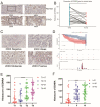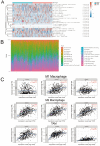Comprehensive analysis of expression signature and immune microenvironment signature of biomarker Endothelin Receptor Type A in stomach adenocarcinoma
- PMID: 35517422
- PMCID: PMC9066206
- DOI: 10.7150/jca.68673
Comprehensive analysis of expression signature and immune microenvironment signature of biomarker Endothelin Receptor Type A in stomach adenocarcinoma
Abstract
Background: EDNRA (Endothelin Receptor Type A) is closely associated with tumor progression in many tumor types. However, the functional mechanism of EDNRA in stomach adenocarcinoma (STAD) remains to be elucidated. Methods: ENDRA expression levels in STAD were assessed. A Receiver Operating Characteristic (ROC) curve was constructed to measure the diagnostic value of EDNRA. The correlation between ENDRA expression levels and patient clinical-pathological characteristics was analyzed. The survival and prognostic significance were validated using Kaplan-Meier and Cox regression and confirmed by the immunohistochemistry cohorts. Differentially expressed genes of EDNRA in STAD were determined, and EDNRA related functional enrichment and biological pathways involved in STAD were obtained by Gene-Set Enrichment Analysis (GSEA). The correlation between EDNRA expression in STAD and immune cell infiltration was assessed using the CIBERSORT and Spearman correlation analysis, and the correlation between EDNRA and TMB, MSI, IC50, and immune checkpoints was examined. Results: EDNRA expression was significantly higher in STAD than in normal tissues (P < 0.001) and associated with worse overall survival (OS). EDNRA expression was significantly associated with T stage, histological type, histologic grade, and TP53 status. Cox regression analysis revealed that primary therapy outcome, age, tumor status, and EDNRA were independent prognostic factors for OS. Multivariate analysis revealed that EDNRA expression, tumor status, age, and primary therapy outcome influenced patient prognosis. GSEA was significantly enriched in several pathways and biological processes, which include Immunoregulatory, Hedgehog, WNT, PI3K-AKT.NK cells, Tem, macrophages, and mast cells were substantially positively correlated with EDNRA expression in the STAD microenvironment. Notably, high EDNRA expression may promote M2 macrophages to block PD-1-mediated immunotherapy and induce immunosuppression. In addition, patients with high expression of EDNRA might be resistant to the treatment of several anti-tumor drugs. Conclusion: Our results suggest that EDNRA was closely related to clinicopathologic characteristics, poor prognosis, and promoted macrophage differentiation and synergistic role in immunosuppression.
Keywords: EDNRA; Immune checkpoint; Immunoregulatory; M2 macrophage; Tumor biomarker.
© The author(s).
Conflict of interest statement
Competing Interests: The authors have declared that no competing interest exists.
Figures











Similar articles
-
High Endothelin Receptor Type A Expression as an Independent Prognostic Biomarker and Correlated with Immune Infiltrates in Stomach Adenocarcinoma.Cancer Manag Res. 2021 Jun 28;13:5013-5026. doi: 10.2147/CMAR.S313078. eCollection 2021. Cancer Manag Res. 2021. PMID: 34234547 Free PMC article.
-
ZBTB10 as a potential prognosis biomarker and correlates with the tumor immune microenvironment in stomach adenocarcinoma.BMC Gastroenterol. 2025 Jun 6;25(1):435. doi: 10.1186/s12876-025-04047-y. BMC Gastroenterol. 2025. PMID: 40481392 Free PMC article.
-
High Expression of ERK-related RASGRF2 predicts Poor prognosis in patients with Stomach Adenocarcinoma and correlates with M2 macrophage.J Cancer. 2021 Oct 22;12(23):7177-7189. doi: 10.7150/jca.63029. eCollection 2021. J Cancer. 2021. PMID: 34729119 Free PMC article.
-
Classification of stomach adenocarcinoma based on fatty acid metabolism-related genes frofiling.Front Mol Biosci. 2022 Aug 26;9:962435. doi: 10.3389/fmolb.2022.962435. eCollection 2022. Front Mol Biosci. 2022. PMID: 36090054 Free PMC article.
-
Identification and characterization of nucleotide metabolism and neuroendocrine regulation-associated modification patterns in stomach adenocarcinoma with auxiliary prognostic assessment and immunotherapy response prediction.Front Endocrinol (Lausanne). 2023 Jan 16;13:1076521. doi: 10.3389/fendo.2022.1076521. eCollection 2022. Front Endocrinol (Lausanne). 2023. PMID: 36726460 Free PMC article. Review.
Cited by
-
Endothelin and the tumor microenvironment: a finger in every pie.Clin Sci (Lond). 2024 Jun 5;138(11):617-634. doi: 10.1042/CS20240426. Clin Sci (Lond). 2024. PMID: 38785410 Free PMC article. Review.
-
Analysis of tumor treatment under interventional ultrasound through structural and temporal dynamics: a bibliometric visualization.Quant Imaging Med Surg. 2024 Dec 5;14(12):8899-8914. doi: 10.21037/qims-24-1233. Epub 2024 Nov 12. Quant Imaging Med Surg. 2024. PMID: 39698601 Free PMC article.
-
Evaluation of vital genes correlated with CD8 + T cell infiltration as prognostic biomarkers in stomach adenocarcinoma.BMC Gastroenterol. 2023 Nov 17;23(1):399. doi: 10.1186/s12876-023-03003-y. BMC Gastroenterol. 2023. PMID: 37978443 Free PMC article.
-
ZP3 Expression in Pancreatic Adenocarcinoma: Its Implications for the Prognosis and Therapy.Protein Pept Lett. 2025;32(2):124-138. doi: 10.2174/0109298665350171241204153202. Protein Pept Lett. 2025. PMID: 39791146
-
Tracing the history of clinical practice of liquid biopsy: a bibliometric analysis.Front Immunol. 2025 May 13;16:1574736. doi: 10.3389/fimmu.2025.1574736. eCollection 2025. Front Immunol. 2025. PMID: 40433362 Free PMC article.
References
-
- Compare D, Rocco A, Nardone G. Risk factors in gastric cancer. European review for medical and pharmacological sciences. 2010;14:302–8. - PubMed
-
- Coutzac C, Pernot S, Chaput N, Zaanan A. Immunotherapy in advanced gastric cancer, is it the future? Critical reviews in oncology/hematology. 2019;133:25–32. - PubMed
LinkOut - more resources
Full Text Sources
Research Materials
Miscellaneous

